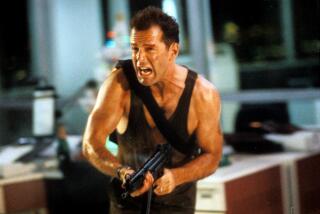When Jeff Bridges is working the camera
- Share via
While filming a scene for “Seabiscuit,” Jeff Bridges stood next to actress Elizabeth Banks in the racetrack grandstands as the horses thundered toward the finish line. The race tightened and the cheering crowd grew increasingly animated. “I was waving my arms,” Bridges recalls, “and — wham! — I hit Elizabeth in the face.”
It was an accident, of course, but Banks’ nose began to bleed. Bridges apologized, made sure she was OK … then reached for his camera.
The image he captured — a serene and stunningly composed photograph — is one of the standouts in “Jeff Bridges: Pictures: Volume Two,” the actor’s new book of photography.
For the last 35 years, Bridges has been taking photographs on the sets of each film he makes. He turns them into yearbooks, which he hands out to cast and crew after the film wraps. (“The photographs celebrate our times together,” he writes in “Volume Two’s” introduction.)
Bridges, who won an Oscar for “Crazy Heart” and legions of fans for his role as the Dude in “The Big Lebowski,” published his first photography book 16 years ago. His new book, with more than 125 black-and-white photographs, offers a backstage pass to life on the set and, specifically, to the making of 22 of Bridges’ films, from “Scenes of the Crime” in 2001 to “Bad Times at the El Royale” last year.
The talent clearly feels at ease posing for one of their own: There’s Justin Timberlake behind the wheel on the set of “The Open Road,” Meryl Streep making the comedy-tragedy faces while shooting “The Giver,” George Clooney hamming it up in “The Men Who Stare at Goats” and Maggie Gyllenhaal quietly sinking into a sofa during the filming of “Crazy Heart.” There are selfies too, including an eerie close-up of a scraggly, eye-patched Bridges on the set of 2010’s “True Grit,” a body hanging from a barren tree branch high above him.
But beyond the access and intimacy — no small thing at a time when celebrity shoots are routinely mediated by a phalanx of PR minders — Bridges’ camera captures a certain spontaneous magic. He uses a quirky panning camera, a Widelux, which relies on a lens that moves on a turret, rendering pictures so wide and with so much “peripheral vision” that they almost wrap around his viewer. The effect nudges us to the center of the chaotic scrum that is moviemaking.
Bridges, 69, refers to the Widelux as a “fickle mistress,” and its extremely slow shutter speed slurs time; he sees the camera as “sort of a missing link between still photography and moving pictures.” The result, which can be both blurry and in focus within a single frame, is an unpredictable but artistic photograph — making the Widelux perhaps the perfect camera for Bridges, who has long looked for the art in life, no matter how unpredictable the results.
On the set, Bridges says, the camera is “always kind of around and handy.” What does he look for? “It’s not like I’m hunting for a particular thing,” he says. “It kind of finds me rather than me finding it, you know? I’m not looking for something significant. I think significance is a stumbling block for the creative process. It gets in the way.”
You might think that wandering around the set watching for “the way the light’s falling” while between scenes could take Bridges out of character. “It’s funny, I used to give myself a bad time when I would get distracted by doing something creative while I should be studying my lines,” he says. “But then I noticed that when I engage creatively, it shakes up all my juices.”
His acting and photography “kind of inform each other,” he says. “It’s all the same stuff. It’s letting it have its way with you — and getting out of the way. If they say, ‘We need you,’ then it’s like, ‘OK, I’ll be right there.’ And you take that same feeling and you bring it into your work.”
There’s no denying Bridges has an eye for small but fascinating moments — he was honored by the International Center of Photography in 2013 — but in these days of CGI-creep, he also feels a sense of mission about what he documents: “To let people know what it was like to be in the movies at this particular time. Because it’s going to change really fast.”
Shapiro is the former editor in chief of Life magazine and author of “What We Keep.”
More to Read
Sign up for our Book Club newsletter
Get the latest news, events and more from the Los Angeles Times Book Club, and help us get L.A. reading and talking.
You may occasionally receive promotional content from the Los Angeles Times.







